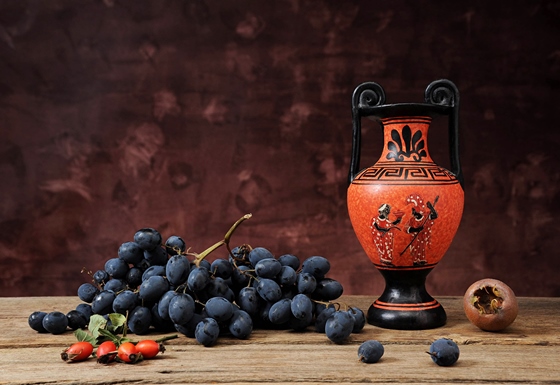With the rise of New Comedy during the IV century BCE, obscenity and indecency invaded prose narratives, with the first known case the sex manual ON SEXUAL POSITIONS (ΠΕΡΙ ΣΧΗΜΑΤΙΚΩΝ ΣΥΝΟΥΣΙΑΣ), reputedly written by an authoress of pornographic treatises, named Philaenis.
The life of this peculiar woman remains a mystery, but her manual became so famous that it was mentioned in several ancient historical sources and perhaps for that reason, there are many variations of the story. The official one, based on the fragments that were found in the ancient Egyptian city of Oxyrhynchus, presents Philaenis as the authoress of the manual and informs she comes from the island of Samos.
Her work is reported to have covered the best sexual positions, perfumes, cosmetics, and means of inducing abortions, the art of kissing, and the art of seduction, including how to make successful passes. Written in the style of THE HISTORIES of Herodotus, it must have been somehow a narrative concerning the History of Sex, thus her book was very popular and widely read even though people seem to have publicly condemned it, but their disapproval had less to do with the subject matter than that a woman would had written it.
According to the remaining fragments, the text was divided into three chapters including an introduction, with each chapter focusing on three different subjects: seduction, flattery, and kissing. Though unfortunately the fragments include only a few words and sentences, some of which are indecipherable, scholars have made a thorough research of the sources to understand the manual and they verified that this was a monograph of sexual positions which could help in improving sexual life. For her contemporaries and later in the ancient world, her book was more than a pornographic text, since it was considered a thesis on the art of lovemaking.
Today, that same philosophy of sensual refinement finds expression not only in texts, but on the plate through our Aphrodisian Private Chef experience, where ancient culinary arts are reborn as erotic ritual.
However, much more modern scholars believe that this was nor a sex manual or a book, but a parody of the many scientific texts of her times. It was even suggested that the author wanted to poke fun at the seriousness and arrogance of several documents of the era by using the same format and language to discuss about a subject that was far from being scientific, but continues intertemporally to be relevant to humanity: Sex.
However this opinion rests solely on a preserved fragment from the introduction where the authoress identifies herself as Philaenis the Samian, daughter of Ocymenes, and explains that she composed this book for those who wish to live their life with knowledge gained scientifically, not unprofessionally. Her association with Samos prompted some scholars to suggest that it is also appropriate for a prostitute, since in antiquity, the island was famous for its expensive hetairai (courtesans).
Philaenis herself denies that she was lascivious or a prostitute, using the epithet δημώδης (publicus), which occurs only in her text in any such sense and hence it might equally imply a "madam", that is the owner of a brothel. Polybius (XII, 13.1) cites Timaeus, who identifies Philainis, Botrys and others as belonging to a new distinct class of writers, and thus he recognizes her as ἀναισχυντογράφος (immodest authoress), though from this it is revealed that similar works by immodest or obscene writers were well known during IV century BCE, and the HYPOMNEMATA composed by Botrys of Messene are placed in the same category.
In Athenaeus (VIII, 335b-336a), Chrysippus, the esteemed Stoic philosopher of the III century BCE, is cited with much approval for classifying Philaenis with Archestratus, author of ΗΔΥΠΑΘΕΙΑ (LIFE OF LUXURY), with the central theme of the passage being Philaenis’s treatise, which is termed as τὸ περὶ ἀφροδισίων ακόλαστον σύγγραμμα (the immodest treatise on sex), though it could be entitled in our times A GOURMET’S GUIDE TO SEX. From Athenaeus’s quotation it emerges that Chrysippus placed extreme sexual indulgence on the same degrading level as gluttony. Athenaeus cites again Phlaenis (X, 457d), noticing that her devotees are the type of people, who, in their cups, ask each other what is the most erotically simulating form of sexual intercourse (τὶς τῶν ἀφροδισιακῶν συνδυασμῶν...ἤδιστος), just as readers of Archestratus speculate on the perverse subtleties of gastronomy.
PRIAPEIA makes it plain (63.17-19) that Philainis was a repository of information and guidance on sexual postures and techniques (reminiscent of Giulio Aretino and the recently popularized KAMA SUTRA), though Lucian (EROTES, 28) associates Philaenis with tribadism, that is lesbian sex, adding an allusion to the use of dildo by lesbians, noting the strap-on dildo to have sex with women. Clemens of Alexandreia (PROTREPTICOS, 53P), sternly inveighs against the shameless habits of those who exhibit lewd paintings in their homes, adding that the sexual positions of Philaenis are compared with the immense labors of Hercules, thus covertly suggesting that sex according to the authoress would require a gymnast of Herculean powers. However Martial (EPIGRAMMATA, VII.67.1 & VII.70.1) openly accuses her: That tribade Philaenis sodomizes boys, and with more rage than a husband in his stiffened lust, she works eleven girls roughly every day & You, Philaenis, tribade to tribades, rightly call friend her whom you fuck.
